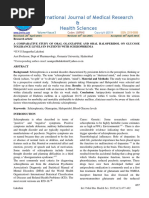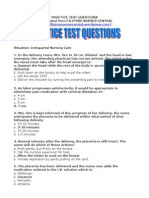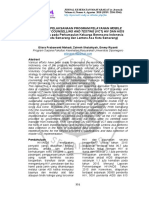51 Uysal Etal
51 Uysal Etal
Uploaded by
editorijmrhsCopyright:
Available Formats
51 Uysal Etal
51 Uysal Etal
Uploaded by
editorijmrhsCopyright
Available Formats
Share this document
Did you find this document useful?
Is this content inappropriate?
Copyright:
Available Formats
51 Uysal Etal
51 Uysal Etal
Uploaded by
editorijmrhsCopyright:
Available Formats
1047
Uysal et al., Int J Med Res Health Sci. 2014; 3(4): 1047-1050
International Journal of Medical Research
&
Health Sciences
www.ijmrhs.com Volume 3 Issue 4 Coden: IJMRHS Copyright @2014 ISSN: 2319-5886
Received: 1
st
Aug 2014 Revised: 1
st
Sep 2014 Accepted: 9
th
Sep 2014
Case report
PONTIAC FEVER ASSOCIATED WITH ERYTHEMA NODOSUM
*
Hilal Bektas Uysal
1
, Hulki Meltem Snmez
2
, Sertan Bulut
3
, Murat Telli
4
1
Assistant Professor,
2
Professor Department of Internal Medicine, Adnan Menderes University School of
Medicine, Aytepemevkii Merkez/ Aydin 09100, Turkey
3
Doctor in Pulmoner Diseases Department, Adnan Menderes University School of Medicine, Aytepemevkii
Merkez/ Aydin 09100, Turkey
4
Assistance Professor in Department of Microbiology, Adnan Menderes University School of Medicine,
Aytepemevkii Merkez/ Aydin 09100, Turkey
*Corresponding author email: hilalbektasuysal@yahoo.com
ABSTRACT
Legionellae are gram-negative bacteria found in clean water sources worldwide. Infection with Legionella
species presents as two distinct clinical forms; Legionnaires' Disease; characterized by pneumonia and Pontiac
Fever; a flu-like illness, characterised by a high attack rate and absence of fatal complications. Cutaneous
manifestations are very uncommon during Legionella infections. To our knowledge; only nine cases of
legionellosis, presenting with skin rash have been reported in the literature. The striking point is, only two men in
this nine cases of Legionella infections, had had Pontiac Fever. Here we present the third case of skin rash
associated with Pontiac fever, reported in the literature to date.
Keywords: Pontiac Fever, Erythema Nodosum, Legionella
INTRODUCTION
Legionellae are gram-negative bacteria found in clean
water sources worldwide. Water is the major
reservoir of Legionella species.
1
Most aerosolized
sources of bacterial-contaminated warm water,
including whirlpool spas, warm spring pools, garden
watering systems, decorative fountains, cooling
towers, and industrial cleaning systems that use high-
pressure water, have been linked to outbreaks of
legionellosis.
2,3
Infection with Legionella species presents as two
distinct clinical forms; Legionnaires' Disease (LD), a
multisystem illness characterized by pneumonia and
Pontiac Fever (PF), a self-limiting flu-like illness.
4
It
is not known why these two different clinical forms
occur, but organism inoculation, transmission modes ,
and host factors seems to be important.
5
Pontiac fever, occurs after exposure to aerosols of
water colonized with Legionella species. Disease
mainly diagnosed in outbreaks, rarely seen
simultaneously.
6
The first outbreak has been reported
in the United States in 1967 in Pontiac, Michigan,
that resulted from the contamination of the central
air-conditioning system from an evaporating
condenser. PF takes its name from this outbreak.
7
LD, is characterized by an acute severe pneumonia
with an average incubation time of 2 to 10 days, and
a low attack rate (0.1 to 5%) in general population.
PF, is the milder form characterised by a short
incubation time of 30-90 h, nearly 70-90% of high
attack rates
8
and absence of fatal or long term
complications
9
. Patients with PF have influenza like
symptoms. After a typical asymptomatic interval of
1248 h after exposure; fever, chills, headache,
DOI: 10.5958/2319-5886.2014.00051.4
1048
Uysal et al., Int J Med Res Health Sci. 2014; 3(4): 1047-1050
myalgia, arthralgia, malaise, sore troat, nonproductive
cough, abdominal pain, nausea occurs in most of the
cases.
7-9
There is no evidence of pneumonia on chest
radiography or physical examination of the patients.
Slight leukocytosis with neutrophilic predominance
may sometimes be detected.
10
Multisystemic extrapulmonary involvement is
observed during Legionella infections, however,
cutaneous manifestations is very uncommon. Only a
few cases of cutaneous involvement have been
described to date, according to our present
knowledge. Here we are reporting a Pontiac Fever
case, associated with ertythema nodosum.
CASE REPORT
A 39 year old woman with no underlying disease,
was admitted to our clinic with malaise, non-
productive cough, sore throat, hoarseness, myalgia,
arthralgia and fever for 3 days followed by warm,
painful, erythematous, non-pruriginous nodules on
bilateral pretibial areas and swelling of the right
ankle.
She did not use alcohol or tobacco. She was living in
a farm and working in the garden care and in the care
of farm animals. She had not travelled recently and
any one of the household had had an upper
respiratory infection within the preceding week.
Upon admission she had a body temperature of 37.5
C, blood pressure of 110/60 mmHg and a pulse rate
of 93 per minute. On physical examination, she had
pale skin and mucous membranes, apical systolic
murmur, unremarkable respiratory system and
abdominal examinations. Arthritis identified on the
right ankle with swelling and pain. She had red
coloured, rounded, approximately 1cm in diameter,
maculer, painful lesions on bilateral forearms and
bilateral pretibial rounded, slightly raised,
nonulcerative, painful, warm, red nodules compatible
with erythema nodosum (Fig-1, Fig-2)
Fig1: In a PF patient the cutaneous involvement of legs
with erythema nodosum
Fig- 2: In a PF patient the cutaneous involvement
of forearms.
Laboratory work-up demonstrated dimorphic anemia
of both iron and vitamin B12 deficiency. Her blood
test results showed the following: white blood cell
count at 9,97x 10
3
/L with remarkable neutrophilia (
82,4%), mild hyponatraemia at 135 mmol/L (normal
range 136-145 mmol/L), an erythrocyte
sedimentation rate during the first hour 64 mm
(normal < 20 mm) and C-reactive protein rate at 65,3
mg/L (Normal range 0-6 mg/L). Chest X-ray was
unremarkable.
Erythema nodosum has been associated with a wide
spectrum of infections, drugs and systemic diseases,
and may also be idiopathic. To consider all possible
etiologies of erythema nodosum a few tests
conducted. Throat swab, nasopharingeal swab, urine
cultures were negative. Antistreptolysin-O (ASO)
titer was in normal range. PPD skin test for
tuberculosis was 7 mm (negative for active infection
in Turkey). Contrast enhanced chest CT scan was
unremarkable. Pathergy test for Behcet disease was
negative. Anti-ds DNA, anti-nuclear antibody and
rheumatoid factor were all negative. There was no
clinical or laboratory alarm sign for malignancy. The
multiplex RT-PCR assay of nasopharingeal swab for
bacteria was positive for Legionella spp. Multiplex
RT-PCR assay of nasopharingeal swab for viruses
was negative. Legionella Urine Antigen Test (UAT)
was negative.
Immediately, bed rest, elevation of the legs and
supportive therapy started. For pain management oral
indomethacin 25 mg, twice a day started.
Two days after the admission, malaise, non-
productive cough, sore troat, hoarseness and myalgia
disappeared. Arthritis on the right ankle regressed and
erythema nodosum nodules evolved from bright red
to a brownish yellow discoloration resembling bruises
on the fifth day of admission.
1049
Uysal et al., Int J Med Res Health Sci. 2014; 3(4): 1047-1050
The patient became asymptomatic on the ninth day of
hospital admission, laboratory examination results
were all normal except the persisting increased
erythrocyte sedimentation rate (43 mm/h). She
discharged with a control plan after 3 weeks .
DISCUSSION
Cutaneous involvement during legionella infections is
very rare, and to our knowledge; only nine cases of
legionellosis, presenting with skin rash have been
reported in the literature
11-15
.The striking point is,
only two men in this nine cases of Legionella
diseases, had had PF.
16
Here we present the third
case of skin rash associated with PF.
The pathogenesis of skin involvement in the progress
of PF is unknown. It was considered to be mediated
either by a toxin produced by the organism or by an
immunological reaction formed by the host to the
bacteria, or other unidentified additional
mechanisms.
13,16
The clinical diagnosis of PF is usually very difficult
in most patients because of its nonspecific
presentation. Thus, the door to successful diagnosis
is, making proper microbiological tests. Serologic
and urinary antigen tests (UAT) are the most useful
routine tests for the diagnosis of PF.
Approximately 50% of the 48 species of Legionella
and 70 distinct serogroups identified have been
associated with human disease. Validated serologic
testing fort he majority of the 70 serogroups have not
been fully developed, only Legionella pneumophilia
serogroup 1 (LP1) can be reliably assayed by urinary
antigen tests.
17
Nonpneumophilia causes of the
disease are particularly difficult to diagnose. The
sensitivity of UAT is, proportionally increased with
the clinical severity of the disease
4
. Thus, patients
with PF may have been undiagnosed because of the
milder clinical course, if only UAT were used.
Previous studies about UATs in PF are very limited
18
.
This may be because these tests were primarily used
for diagnosis of hospitalised patients. Thus, the
validity of these laboratory tests for patients with
mild clinical illness and not demanding hospital
admission, is not clear. In our case the negative result
of UAT, demonstrates the cause of the PF is, an
another species, or serogroup of Legionella, rather
than LP1.
There is no agreed-upon definition of Pontiac fever.
The diagnosis is usually made on the basis of
epidemiologic, clinical, laboratory, and
environmental microbiology findings. Because of its
benign course and the absence of specific findings,
the occurrence of PF is often undiagnosed. Although,
the disease is self-limiting and patients recover
without treatment, the diagnosis is very important.
CONCLUSION
The diagnosis of PF is a marker of patients
environmental contamination by Legionella and
thereby should be a sign for taking all prevention
measures.
The case reported here demonstrates the importance
of using additional diagnostic methods (RT-PCR),
besides the fast and easy to perform urinary antigen
tests, to obtain a more accurate diagnosis, if
suspected. Furthermore, this case shows that PF can
be associated with cutaneous involvement.
Conflict of Interest :Nil
REFERENCES
1. Fliermans CB, Cherry WB, Orrison LH,
Smith SJ, Tison DL, Pope HD. Ecological
distribution of Legionella pneumophila.
Appl. Environ. Microbiol.1981; 41:916.
2. Fraser DW, Deubner DC, Hill DL, Gilliam
DK. Non pneumonic, short-incubation-period
legionellosis (Pontiac fever) in men who
cleaned a steam turbine condenser. Science
1979; 205:6901
3. Jones TF, Benson RF, Brown EW, Rowland
JR, Crosier SC, Schaffner W. Epidemiologic
investigation of a restaurant-associated
outbreak of Pontiac fever. Clin Infect Dis
2003; 371:2927
4. Diederen B. Legionella species and
Legionnaires Disease, Journal of Infection.
2008; 56:1-12
5. Mandell GL, Bennett JE, Dolin R Eds,
Principles and Practice of Infectious
Diseases, 4th edition, Churchill Livingstone,
1995: 2087.
6. Fenstersheib M, Miller M, Diggins C.
Outbreak of Pontiac fever due to Legionella
anisa. Lancet 1990; 336:3537
1050
Uysal et al., Int J Med Res Health Sci. 2014; 3(4): 1047-1050
7. Glick TH, Gregg MB, Berman B, Mallison
G, Rhodes WW Jr, Kassanoff I. Pontiac
fever: an epidemic of unknown etiology in a
health department.I. Clinical and
epidemiologic aspects. Am J Epidemiol
1978; 107:14960
8. Pancer K, Stypulkowska-Misiurewicz H:
Pontiac Fever non-pneumonic legionellosis.
Przegl Epidemiol 2003; 576:7-12
9. Fields BS, Haupt T, Davis JP, Arduino MJ,
Miller HP, Butler JC: Pontiac fever due to
Legionella micdadei from whirlpool Spa:
possible role of bacterial endotoxin. J Infect
Dis 2001; 184:1289-92
10. Luttichau HR, Vinther C, Uldum SA. An
outbreak of Pontiac fever among children
following use of a whirlpool. Clin Infect
Dis.1998; 26: 1374-78
11. Randall TW, Naidoo P, Newton KA.
Legionnaires disease in Port Elisabeth. S Af
Med J 1980; 581:7-23.
12. Helms CM, Johnson W, Donaldson MF.
Pretibial rash in Legionella pneumophila
pneumonia. JAMA 1981; 2451:758-59
13. Allen TP, Fried JS, Wiegmann TB.
Legionnaires disease associated with rash
and renal failure. Arch Intern Med 1985;
145:729-30
14. Calza L, Briganti E, Casolari S.
Legionnaires disease associated with
macular rash: two cases. Acta Derm Venereol
2005; 85:342-44
15. Ziemer M , Ebert K, Schreiber G, Voigt R.
Exanthema in Legionnaires disease
mimicking a severe cutaneous drug reaction.
Clin Exp Derm 2009; 34:72-74
16. Spitalny KC, Vogt RL, Witherell LE.
National survey on outbreaks associated with
whirlpool spas. Am J Public Health 1984; 74:
725-6
17. Fields BS, Benson RF, Besser RE.
Legionella and Legionnaires disease: 25
years of investigation. Clin Microbial Rev
2002; 15:506-26
18. Edelstein PH. Urine antigen tests positive for
Pontiac fever: implications for diagnosisand
pathogenesis. Clin. Infect. Diseases 2002;
44:229-31
You might also like
- Fluid & Electrolytes Cheat Sheet v3Document1 pageFluid & Electrolytes Cheat Sheet v3faten100% (3)
- Intraoperative Neurophysiological Monitoring 2011Document415 pagesIntraoperative Neurophysiological Monitoring 2011dr.darch100% (1)
- LepsDocument4 pagesLepslynharee100% (1)
- Acute Fulminent Leptospirosis With Multi-Organ Failure: Weil's DiseaseDocument4 pagesAcute Fulminent Leptospirosis With Multi-Organ Failure: Weil's DiseaseMuhFarizaAudiNo ratings yet
- Staphy 2Document5 pagesStaphy 2Alexandra MariaNo ratings yet
- 1 s2.0 S1755001711000558 MainDocument3 pages1 s2.0 S1755001711000558 Mainanon_667170362No ratings yet
- Prolonged Fever Occurring During Treatment of Pulmonary Tuberculosis - An Investigation of 40 CasesDocument3 pagesProlonged Fever Occurring During Treatment of Pulmonary Tuberculosis - An Investigation of 40 Casesসোমনাথ মহাপাত্রNo ratings yet
- Influenza A H5N1 and HIV Co-Infection: Case ReportDocument5 pagesInfluenza A H5N1 and HIV Co-Infection: Case ReportSiraj AhmadNo ratings yet
- Orthinosis Query FeverDocument6 pagesOrthinosis Query Feversomebody_maNo ratings yet
- 51 Sumantro EtalDocument3 pages51 Sumantro EtaleditorijmrhsNo ratings yet
- A 45-Year-Old Man With Shortness of Breath, Cough, and Fever BackgroundDocument7 pagesA 45-Year-Old Man With Shortness of Breath, Cough, and Fever BackgroundFluffyyy BabyyyNo ratings yet
- Case Study_Pulmonary Tuberculosis_Group 4_BSMT-2BDocument9 pagesCase Study_Pulmonary Tuberculosis_Group 4_BSMT-2BJolan Fernando HerceNo ratings yet
- A Case of Typhoid Fever Presenting With Multiple ComplicationsDocument4 pagesA Case of Typhoid Fever Presenting With Multiple ComplicationsCleo CaminadeNo ratings yet
- Jurding Nisya Interna DR ArifDocument16 pagesJurding Nisya Interna DR ArifnisyadefiaNo ratings yet
- A. Biswas, R. Kumar, A. Chaterjee, A. PanDocument5 pagesA. Biswas, R. Kumar, A. Chaterjee, A. PanShofura AzizahNo ratings yet
- Eritema Nodoso: Causas Más Prevalentes en Pacientes Que Se Hospitalizan para Estudio, y Recomendaciones para El DiagnósticoDocument7 pagesEritema Nodoso: Causas Más Prevalentes en Pacientes Que Se Hospitalizan para Estudio, y Recomendaciones para El DiagnósticoCamilo PerillaNo ratings yet
- Fulminant Hemophagocytic Lymphohistiocytosis Induced by Pandemic A (H1N1) Influenza: A Case ReportDocument4 pagesFulminant Hemophagocytic Lymphohistiocytosis Induced by Pandemic A (H1N1) Influenza: A Case ReportrahNo ratings yet
- Jchimp 5 26322Document4 pagesJchimp 5 26322Jongga SiahaanNo ratings yet
- Prezentare Caz Leptospiroza PDF TTF 9501 1Document4 pagesPrezentare Caz Leptospiroza PDF TTF 9501 1suvaialaluciamadalinNo ratings yet
- Generalized Tetanus in A 4-Year Old Boy Presenting With Dysphagia and Trismus: A Case ReportDocument4 pagesGeneralized Tetanus in A 4-Year Old Boy Presenting With Dysphagia and Trismus: A Case Reportzul090No ratings yet
- 2 +Severe+LeptospirosisDocument6 pages2 +Severe+LeptospirosisYhuzz Toma5No ratings yet
- ChangesinsomehaematologicalparametersintyphoidpatientsattendingDocument6 pagesChangesinsomehaematologicalparametersintyphoidpatientsattendingMasita NasutionNo ratings yet
- An Atypical Presentation of A Patient With Renal AbscessDocument3 pagesAn Atypical Presentation of A Patient With Renal AbscessJose Francisco Zamora ScottNo ratings yet
- Mistaken Identity Reporting Two Cases of Rare Fo 2024 International JournalDocument7 pagesMistaken Identity Reporting Two Cases of Rare Fo 2024 International JournalRonald QuezadaNo ratings yet
- A Rare Cause of Endocarditis: Streptococcus PyogenesDocument3 pagesA Rare Cause of Endocarditis: Streptococcus PyogenesYusuf BrilliantNo ratings yet
- HellowDocument6 pagesHellowafina rasaki asriNo ratings yet
- Atypical MeaslesDocument2 pagesAtypical MeaslesBagusPranataNo ratings yet
- Pulmonary Tuberculosis As A Differential Diagnosis of PneumoniaDocument18 pagesPulmonary Tuberculosis As A Differential Diagnosis of PneumoniaKadek AyuNo ratings yet
- Case 1Document4 pagesCase 1Irsanti SasmitaNo ratings yet
- A Short Review On Leptospirosis Clinical ManifestationsDocument4 pagesA Short Review On Leptospirosis Clinical Manifestationsgrace liwantoNo ratings yet
- L. Ari Jutkowitz, VMD, DACVECC Michigan State University East Lansing, MI, USADocument5 pagesL. Ari Jutkowitz, VMD, DACVECC Michigan State University East Lansing, MI, USAyoedanuxNo ratings yet
- A Young Traveller Presenting With Typhoid Fever After Oral Vaccination: A Case ReportDocument9 pagesA Young Traveller Presenting With Typhoid Fever After Oral Vaccination: A Case ReportMarscha MaryuanaNo ratings yet
- Cardiac Leptospirosis: Iralphuaborque Md14thbatch Hds DocharlabardaDocument15 pagesCardiac Leptospirosis: Iralphuaborque Md14thbatch Hds DocharlabardaJr. CesingNo ratings yet
- Pulmonary Miliary Tuberculosis Complicated With Tuberculous Spondylitis An Extraordinary Rare Association: A Case ReportDocument5 pagesPulmonary Miliary Tuberculosis Complicated With Tuberculous Spondylitis An Extraordinary Rare Association: A Case ReportIsmail Eko SaputraNo ratings yet
- Stacy PearlsDocument8 pagesStacy Pearlselenagate7No ratings yet
- Level of Evidence 3Document4 pagesLevel of Evidence 3andamar0290No ratings yet
- Faggionvinholo2020 Q1Document5 pagesFaggionvinholo2020 Q1NasriNo ratings yet
- Rodgers 2015Document5 pagesRodgers 2015No LimitNo ratings yet
- 08 Pneumonia Review ofDocument4 pages08 Pneumonia Review ofMonika Margareta Maria ElviraNo ratings yet
- Tetanus: Clostridium Tetani. The Disease Was First Described in The 14th Century by John of ArderneDocument5 pagesTetanus: Clostridium Tetani. The Disease Was First Described in The 14th Century by John of Ardernedefitri sariningtyasNo ratings yet
- Pancytopenia Secondary To Bacterial SepsisDocument16 pagesPancytopenia Secondary To Bacterial Sepsisiamralph89No ratings yet
- Leptospirosis: Tropical To Subtropical India: EditorialDocument2 pagesLeptospirosis: Tropical To Subtropical India: EditorialTiara AnggrainiNo ratings yet
- Pneumococcal Infection in Patients With Systemic Lupus ErythematosusDocument4 pagesPneumococcal Infection in Patients With Systemic Lupus ErythematosusifamhmudahNo ratings yet
- A Case of Lupus Pneumonitis Mimicking As Infective PneumoniaDocument4 pagesA Case of Lupus Pneumonitis Mimicking As Infective PneumoniaIOSR Journal of PharmacyNo ratings yet
- Delay in Diagnosis of Extra-Pulmonary Tuberculosis by Its Rare Manifestations: A Case ReportDocument5 pagesDelay in Diagnosis of Extra-Pulmonary Tuberculosis by Its Rare Manifestations: A Case ReportSneeze LouderNo ratings yet
- Case Report Article: A Rare Site For Primary Tuberculosis - TonsilsDocument3 pagesCase Report Article: A Rare Site For Primary Tuberculosis - Tonsilsmanish agrawalNo ratings yet
- Dental Journal: Oral Lesions As A Clinical Sign of Systemic Lupus ErythematosusDocument6 pagesDental Journal: Oral Lesions As A Clinical Sign of Systemic Lupus ErythematosusIin Ardi ANo ratings yet
- Minor 2013Document2 pagesMinor 2013Pablo Saborio ChaconNo ratings yet
- Salmonella Hepatitis: An Uncommon Complication of A Common DiseaseDocument3 pagesSalmonella Hepatitis: An Uncommon Complication of A Common DiseaseMudassar SattarNo ratings yet
- Tubercular ScleritisDocument5 pagesTubercular Scleritismutya yulindaNo ratings yet
- CAP by TaiwoDocument9 pagesCAP by TaiwoTaiwo DavidNo ratings yet
- Acute Epiglottitis in The Immunocompromised Host: Case Report and Review of The LiteratureDocument5 pagesAcute Epiglottitis in The Immunocompromised Host: Case Report and Review of The Literaturerosandi sabollaNo ratings yet
- Fungal Disease IPA Vs SAIA Vs ABPA With Invasive AspergillosisDocument11 pagesFungal Disease IPA Vs SAIA Vs ABPA With Invasive AspergillosisnelumNo ratings yet
- Elizabeth King I ADocument3 pagesElizabeth King I AAlba UrbinaNo ratings yet
- Leptospirosis CasosDocument2 pagesLeptospirosis CasosfelipeNo ratings yet
- Aair 6 454270Document3 pagesAair 6 454270tomasjohn123No ratings yet
- Pediatric Systemic Lupus Erythematosus Associated With AutoimmuneDocument9 pagesPediatric Systemic Lupus Erythematosus Associated With AutoimmunegistaluvikaNo ratings yet
- FuoDocument4 pagesFuoDevi Eliani ChandraNo ratings yet
- Henoch-Schonlein Purpura Associated With Bee Sting Case Report PDFDocument7 pagesHenoch-Schonlein Purpura Associated With Bee Sting Case Report PDFjoshkelNo ratings yet
- Diagnosis and Treatment of Chronic CoughFrom EverandDiagnosis and Treatment of Chronic CoughSang Heon ChoNo ratings yet
- Ijmrhs Vol 3 Issue 4Document294 pagesIjmrhs Vol 3 Issue 4editorijmrhsNo ratings yet
- Ijmrhs Vol 4 Issue 2Document219 pagesIjmrhs Vol 4 Issue 2editorijmrhsNo ratings yet
- Ijmrhs Vol 4 Issue 4Document193 pagesIjmrhs Vol 4 Issue 4editorijmrhs0% (1)
- Ijmrhs Vol 4 Issue 3Document263 pagesIjmrhs Vol 4 Issue 3editorijmrhsNo ratings yet
- Ijmrhs Vol 3 Issue 3Document271 pagesIjmrhs Vol 3 Issue 3editorijmrhsNo ratings yet
- Ijmrhs Vol 3 Issue 1Document228 pagesIjmrhs Vol 3 Issue 1editorijmrhsNo ratings yet
- Ijmrhs Vol 3 Issue 2Document281 pagesIjmrhs Vol 3 Issue 2editorijmrhsNo ratings yet
- Williams-Campbell Syndrome-A Rare Entity of Congenital Bronchiectasis: A Case Report in AdultDocument3 pagesWilliams-Campbell Syndrome-A Rare Entity of Congenital Bronchiectasis: A Case Report in AdulteditorijmrhsNo ratings yet
- Ijmrhs Vol 2 Issue 2Document197 pagesIjmrhs Vol 2 Issue 2editorijmrhsNo ratings yet
- Ijmrhs Vol 2 Issue 3Document399 pagesIjmrhs Vol 2 Issue 3editorijmrhs100% (1)
- Ijmrhs Vol 2 Issue 4Document321 pagesIjmrhs Vol 2 Issue 4editorijmrhsNo ratings yet
- Ijmrhs Vol 1 Issue 1Document257 pagesIjmrhs Vol 1 Issue 1editorijmrhsNo ratings yet
- 48 MakrandDocument2 pages48 MakrandeditorijmrhsNo ratings yet
- Ijmrhs Vol 2 Issue 1Document110 pagesIjmrhs Vol 2 Issue 1editorijmrhs100% (1)
- 40vedant EtalDocument4 pages40vedant EtaleditorijmrhsNo ratings yet
- Recurrent Cornual Ectopic Pregnancy - A Case Report: Article InfoDocument2 pagesRecurrent Cornual Ectopic Pregnancy - A Case Report: Article InfoeditorijmrhsNo ratings yet
- 47serban Turliuc EtalDocument4 pages47serban Turliuc EtaleditorijmrhsNo ratings yet
- 45mohit EtalDocument4 pages45mohit EtaleditorijmrhsNo ratings yet
- 41anurag EtalDocument2 pages41anurag EtaleditorijmrhsNo ratings yet
- 35krishnasamy EtalDocument1 page35krishnasamy EtaleditorijmrhsNo ratings yet
- 38vaishnavi EtalDocument3 pages38vaishnavi EtaleditorijmrhsNo ratings yet
- Pernicious Anemia in Young: A Case Report With Review of LiteratureDocument5 pagesPernicious Anemia in Young: A Case Report With Review of LiteratureeditorijmrhsNo ratings yet
- 34tupe EtalDocument5 pages34tupe EtaleditorijmrhsNo ratings yet
- 36rashmipal EtalDocument6 pages36rashmipal EtaleditorijmrhsNo ratings yet
- 37poflee EtalDocument3 pages37poflee EtaleditorijmrhsNo ratings yet
- 31tushar EtalDocument4 pages31tushar EtaleditorijmrhsNo ratings yet
- 33 Prabu RamDocument5 pages33 Prabu RameditorijmrhsNo ratings yet
- 28nnadi EtalDocument4 pages28nnadi EtaleditorijmrhsNo ratings yet
- Fast DPL CTDocument6 pagesFast DPL CTnmyza89No ratings yet
- Assessment of InfantDocument6 pagesAssessment of InfantYashoda Satpute100% (1)
- Ajmcr-10-10-2 PublishedDocument5 pagesAjmcr-10-10-2 PublishedsaNo ratings yet
- Health Post - Transforming Lives - The Fascinating World of Transplant MedicineDocument4 pagesHealth Post - Transforming Lives - The Fascinating World of Transplant MedicineihealthmailboxNo ratings yet
- Xamidea Human ReproductionDocument42 pagesXamidea Human Reproductionkeren spamzNo ratings yet
- E6 Toxicity Prediction Using Protox Ii HandoutDocument7 pagesE6 Toxicity Prediction Using Protox Ii HandoutCarissa IslaNo ratings yet
- Jospt 2021 9804Document12 pagesJospt 2021 9804Jacinta SeguraNo ratings yet
- Англ тести фармDocument138 pagesАнгл тести фармRodriguez Vivanco Kevin DanielNo ratings yet
- ProtozoologyDocument20 pagesProtozoologyAnugat Jena0% (1)
- Histrionic Personality DisorderDocument3 pagesHistrionic Personality DisorderDr. Celeste Fabrie100% (3)
- Pharmacology TableDocument9 pagesPharmacology TableMaryam KhushbakhatNo ratings yet
- Report By: Rio and Ria Nofuente: Click To Edit Master Subtitle StyleDocument62 pagesReport By: Rio and Ria Nofuente: Click To Edit Master Subtitle Stylejoycebuquing0% (1)
- Cell Wall Inhibitor PPT SlideDocument47 pagesCell Wall Inhibitor PPT Slidekhawaja sahabNo ratings yet
- Eye Essentials Cataract Assessment Classification and ManagementDocument245 pagesEye Essentials Cataract Assessment Classification and ManagementKyros1972No ratings yet
- Signs and Symptom For UveitisDocument4 pagesSigns and Symptom For UveitisVan KochkarianNo ratings yet
- Practice Test QuestionsDocument14 pagesPractice Test QuestionsFilipino Nurses CentralNo ratings yet
- OsteoarthritisDocument18 pagesOsteoarthritisSaya MenangNo ratings yet
- Silverstein 1993Document4 pagesSilverstein 1993KamilaNo ratings yet
- Analisa Kasus HIPERGLIKEMIDocument30 pagesAnalisa Kasus HIPERGLIKEMIanis dwi prakasiwiNo ratings yet
- Voluntary Counselling and Testing (VCT) Hiv Dan AidsDocument7 pagesVoluntary Counselling and Testing (VCT) Hiv Dan AidsNeri Bela RestuNo ratings yet
- 150 Homeopathy Cases by Kadwa With Repertorial AnalysisDocument138 pages150 Homeopathy Cases by Kadwa With Repertorial Analysisabckadwa100% (1)
- Paediatric Respiratory Medicine: Key PointsDocument8 pagesPaediatric Respiratory Medicine: Key PointsAbdi KebedeNo ratings yet
- Routes of Administration of DrugDocument40 pagesRoutes of Administration of DrugNova AzzuEra Sweetygirl100% (1)
- Treatment Options of Pelvic and Acetabular Fractures in Patients With Osteoporotic BoneDocument12 pagesTreatment Options of Pelvic and Acetabular Fractures in Patients With Osteoporotic Bonefajri_amienNo ratings yet
- Pre-Employment Medical Examinations (PEME) Centres: The Importance of PEMEDocument3 pagesPre-Employment Medical Examinations (PEME) Centres: The Importance of PEMEDrago DragicNo ratings yet
- Micra Physician BrochureDocument5 pagesMicra Physician BrochureRichiNo ratings yet
- Stroke Care: A Practical Manual 3rd Edition Rowan Harwood all chapter instant downloadDocument51 pagesStroke Care: A Practical Manual 3rd Edition Rowan Harwood all chapter instant downloadpilonrungem6100% (3)
- IMPACT COVID Positioning Strategy Memo - Taking The Win Over Covid-19Document2 pagesIMPACT COVID Positioning Strategy Memo - Taking The Win Over Covid-19adan_infowars100% (3)





















































































































